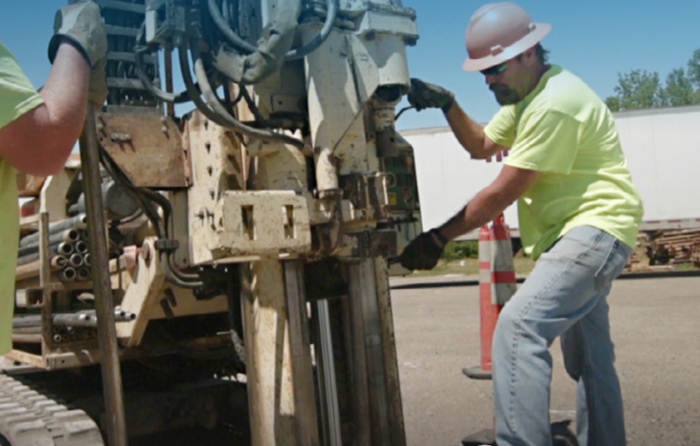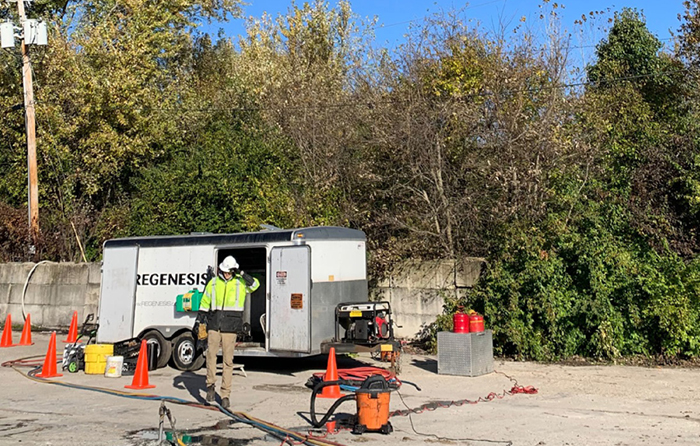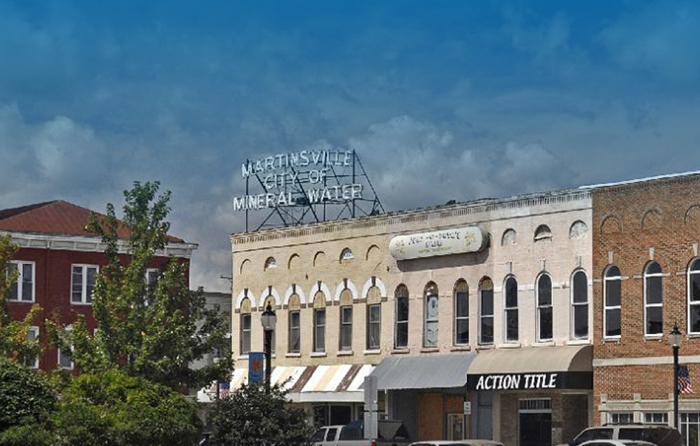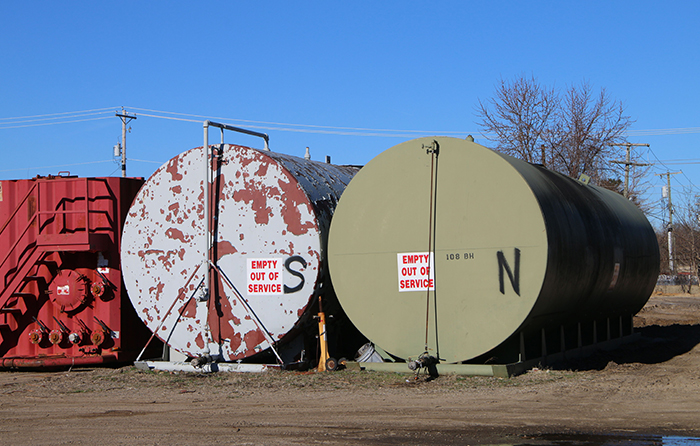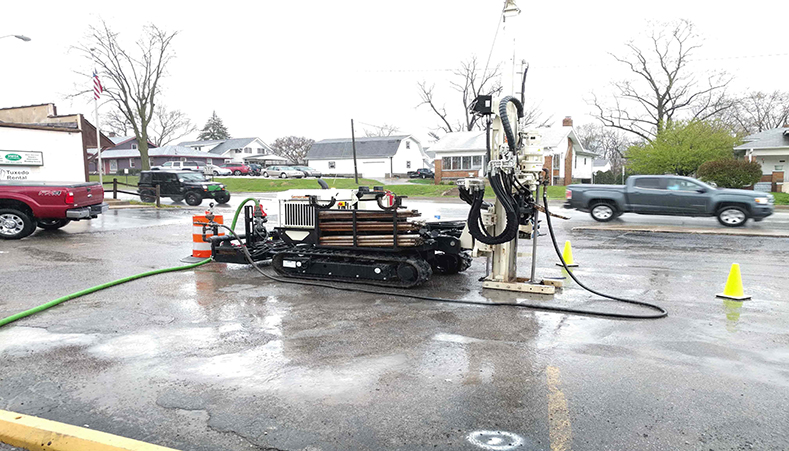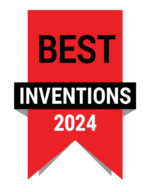Closure Moves Forward at Former Dry Cleaner Site
Case study highlights:
- Remediation achieved site cleanup objectives and site closure from IDEM requested
- Multi-faceted remedial approach implemented to address soil, groundwater and vapor intrusion
- 3-D Microemulsion outperformed EVO in pilot study, demonstrating enhanced capability in rapidly reducing PCE
A former drycleaners site in Central Indiana employed a comprehensive remediation strategy to address on and offsite soil and groundwater contamination caused by chlorinated solvents, primarily perchloroethylene (PCE) and its byproducts. Using an enhanced reductive dichlorination (ERD) approach, the team strategically applied 3-D Microemulsion®, Bio-Dechlor INOCULUM® Plus (BDI), and a soluble ferrous iron substrate to the groundwater plume to facilitate enhanced reductive dechlorination of these contaminants, transforming them into harmless byproducts. This proven treatment substantially reduced the groundwater plume, leaving only lowlevel residual contamination that is effectively managed through institutional controls. Following these results, a site closure request under the state’s Voluntary Remediation Program (VRP) is currently under review by the Indiana Department of Environmental Management (IDEM).
Site Goals Met Within 60 Days
Case study highlights:
- TCE contribution to the plume was eliminated following the application.
- This reduction has been continuously maintained more than three years post-application.
- The highly controlled PlumeStop injection resulted in no surfacing inside the building.
This case study reviews the site of a large-scale in situ groundwater treatment of trichloroethene (TCE) at a former industrial manufacturing facility in the Midwest that quickly achieved and then sustained performance objectives. TCE and low concentrations of other chlorinated volatile organic compounds (CVOCs), cis-1,2-dichloroethene, vinyl chloride, and 1,1,1-trichloroethane, were treated using an innovative sorption-enhanced reductive dechlorination (ERD) approach virtually eliminating contaminants by the first monitoring event within 60 days of application. A permeable reactive barrier (PRB), installed at the site property boundary, has maintained 100 percent reduction in TCE for over three years, meeting the application’s performance objectives by cutting off the site’s contribution to a more extensive groundwater TCE plume.
Treatment Solution for Large TCE Plume Saves Client $380,000
Case study highlights:
- Large TCE plume effectively treated using combined technology solution from REGENESIS, including PlumeStop and S-MicroZVI
- Accurate mapping of CVOC flux zones using FluxTracers saves $380,000 in project costs
- Safe and efficient installation meets time and budget requirements
This case study reviews a former manufacturing facility in Indianapolis that had released high levels of chlorinated solvents into the groundwater, creating a large plume extending to the White River. A combined in situ biogeochemical reduction solution rapidly mitigated the threat to river and saved the client $380,000. Wilcox Environmental Engineering, Inc., a leading engineering and consulting firm based in Indianapolis, was hired by the responsible party to investigate the site. After evaluating the remedial options, Wilcox worked with REGENESIS to design a solution for in situ remediation of the TCE plume using biogeochemical reduction in the onsite plume area and sorption-enhanced chemical reduction in the offsite plume. This approach entailed placing permeable reactive barriers (PRBs) perpendicular to groundwater flow in strategic plume areas.
No Further Action for Large PCE Plume Under Main Street, USA
Case study highlights:
- Closure achieved for a large chlorinated solvent plume in an urban area
- PCE sources rapidly eliminated and plume efficiently treated using a suite of REGENESIS in situ remediation technologies
- Despite access limitations, large PCE plume eliminated, resulting in NFA
This case study reviews a former dry cleaner site in a small town in western Indiana, where site regulatory closure was achieved after a large dissolved-phase PCE groundwater plume was successfully treated using PlumeStop, enhanced reductive dechlorination (ERD) amendments and S-MicroZVI from REGENESIS. Patriot Engineering, a leading Midwest environmental consulting firm, headquartered in Indianapolis, specified ERD as the most practical and economically viable method to effectively treat the large plume. Patriot’s strategy to achieve closure was to significantly reduce the PCE plume and then to demonstrate plume stability through post-remediation monitoring. By combining remediation technologies from REGENESIS with a highly efficient and cost-effective remediation design, Patriot’s treatment approach eliminated the PCE plume. Subsequent performance monitoring and analysis completed by Patriot demonstrated plume stability, earning the site a No Further Action status from Indiana Department of Environmental Management (IDEM).
Reductive Dechlorination Approach Treats Large Chlorinated Solvent Plume
Case study highlights:
- Innovative combined remedy on active site effectively eliminates risk to adjacent property
- Remedy from REGENESIS chosen based on proven effectiveness in treating similar large CVOC plumes
- Design Verification Testing and placement validation guide a successful remedial application
This case study reviews the successful in-situ treatment of chlorinated solvents at a former food processing plant located in a suburb south of Indianapolis. PlumeStop, S-MicroZVI, 3DME and BDI Plus were used in combination to strongly inhibit CVOC plume migration near the site property boundary while enhancing abiotic and biotic degradation of CVOCs at this location and in the upgradient plume area. Patriot Engineering and Environmental, Inc. (Patriot), a leading consulting firm based in Indianapolis, investigated the site, discovering contaminants had migrated from an unidentified source and formed a large plume. In addition, it was found that the plume was being pulled toward a former (now inactive) public water supply well. The primary chlorinated volatile organic compounds (CVOCs) detected in the plume were tetrachloroethene (PCE), trichloroethene (TCE), and cis-1,2-dichloroethene (cis-DCE).
No Further Action Granted, Allowing Site Redevelopment to Move Forward
Case study highlights:
- PetroFix rapidly reduces PHC contaminants to achieve closure goals and avoid future disruption and cost exposure
- EnviroForensics, an Indianapolis-based environmental consulting firm expert in developing site closure strategies, was contracted by the town to pursue regulatory closure
- PetroFix treatment eliminated the need for costly groundwater monitoring and unnecessary time and disruption to document plume stability
This case study reviews four orphan underground storage tanks (USTs) that were discovered at a former gas station site slated for redevelopment in a Southern Indiana town. Since the site was scheduled for redevelopment, it was necessary to eliminate future cost and disruption and demonstrate plume stability and Monitored Natural Attenuation (MNA) conditions. EnviroForensics was contracted by the town to pursue regulatory closure. Since the site was scheduled for redevelopment, it was necessary to eliminate future cost and disruption and demonstrate plume stability and Monitored Natural Attenuation (MNA) conditions. EnviroForensics decided to treat these low-level, residual impacts by injecting PetroFix® into the underlying groundwater. Following completion of the application design using PetroFix Design Assistant online software at www.petrofix.com/design, Enviroforensics mobilized to the site and completed the application in July 2019.
PetroFix Pilot Study Leads To Successful Full-Scale Application
Case study highlights:
- Previous pilot testing results provided promising results leading to a full-scale application
- PetroFix is designed to remediate petroleum contamination completely at the lowest total cost to closure
- Site closure strategy included reducing groundwater concentrations, inhibiting plume migration, and demonstrating plume stability site-wide
This case study reviews a full-scale PetroFix remediation program that was designed and implemented at seven locations to treat petroleum hydrocarbons (PHCs) following a successful field pilot test.
Two post-injection groundwater sampling events were completed in June and September 2019. In December 2019, a supplemental PetroFix injection was completed in the PHC source area onsite following the PersulfOx and ORC-A pretreatment step and groundwater equilibration. Additionally, a new treatment area was added where a small quantity of PetroFix was injected.
PlumeStop Arrests PCE in Fast Moving Aquifer
Case study highlights:
- PlumeStop effectively treated the plume in the well-oxygenated, sand and gravel lithology
- 99% reduction of PCE ~30 days after the application in key monitoring wells
- Demonstration of PRB leading to full-scale treatment in Spring 2020
This case study reviews a former dry-cleaning site in Martinsville, Indiana that had a perchloroethylene (PCE) release which contaminated the community’s groundwater with concentrations in excess of 370 parts per billion (ppb). After a successful pilot test and four monitoring events, environmental consulting firm Wilcox Environmental Engineering and the site owner decided to implement a full-scale application using PlumeStop. The sand and gravel aquifer created a challenging problem due to the high flow regime, with a groundwater velocity of approximately 1,560 ft/year and oxygenated geochemistry which had limited natural attenuation. The property owner, interested in the potential sale of the site, engaged Wilcox, a regional environmental consulting firm based in Indianapolis. After a thorough evaluation of possible technologies, Wilcox determined that PlumeStop® Liquid Activated Carbon™ in combination with HRC® and BDI Plus® could prevent the plume from migrating and would work in the well-oxygenated, sand and gravel lithology.
PetroFix Pilot Study Leads to Full-Scale Application
Case study highlights:
- Beta test of PetroFix provided promising results leading to a full-scale application
- At just one month post-injection, the petroleum VOCs and gasolinerange organics were essentially eliminated from the groundwater and remain so at nine months
- PetroFix remedial solution is designed to remediate petroleum contamination completely at the lowest total cost to closure
- Collaborative remediation success between Patriot, Microbial Insights, and REGENESIS
This case study reviews a former bulk petroleum storage facility where a groundbreaking application of PetroFix™ Remediation Fluid, a micro-scale carbon suspension with soluble electron acceptors, is successfully treating petroleum hydrocarbons to IDEM standards. REGENESIS worked with Patriot Engineering and Environmental to develop a remediation solution using PetroFix, which is uniquely designed to address petroleum hydrocarbon contaminants. The site was considered a viable candidate for the beta test, due to the high contaminant levels and provided a good test of the product’s performance at high concentrations. REGENESIS and Patriot agreed to move forward with the development of the beta test with the intention of evaluating its possible full-scale use following the results of the test. The promising results from the beta test and 12 months of post-injection monitoring indicate PetroFix to be a viable remedial option for this site.
Enhanced Reductive Dechlorination Showing Positive Returns at Indiana Dry Cleaning Site
Project Highlights
- Combined remedies approach using an Enhanced Reductive Dechlorination (ERD) process successfully remediated an Indiana drycleaning site
- ERD process chosen eliminates need for long-term monitoring
- Contaminant concentrations reduced from thousands of μg/L pre-injection to single digits one month post-injection

Project Summary
While the surrounding Mooresville, Indiana community applauds Crest Cleaners for proactively cleaning up a previously unidentified hazardous mess that was left behind from historic dry cleaning practices, the workhorses remediating the contamination are grinding away below the subsurface. Tiny microorganisms are destroying the PCE in the groundwater and reducing the concentration of the contaminant. It’s all a part of the “Enhanced Reductive Dechlorination,” (ERD) process, which is the primary approach of the Remedial Work Plan (RWP) being implemented by EnviroForensics®.
In addition to the potential for human health risks at the site as a result of soil or groundwater exposure, the contaminant plume in the groundwater represented a potential vapor intrusion risk to an offsite building. The project team debated between two viable options:
- Install, monitor, and maintain a Sub-Slab Depressurization System (SSDS) at the offsite location to mitigate the potentially harmful vapors underneath the building, which would have required years of maintenance and groundwater sampling; or
- Implement an ERD application to reduce the concentration of the groundwater plume, and eliminate potential vapor intrusion issues.
Based on the overall benefit to the community and to reduce stress and aggravation to adjacent property owners that comes with long-term monitoring, the project team chose option two.
Here’s how the remediation at this site worked. Naturally occurring bacteria called Dehalococcoides ethanogenes (DHC) are in the groundwater completing a process called reductive dechlorination where the chlorine atoms are cleaved off and replaced by hydrogen atoms. This process continues until the resulting compound is no longer dangerous. At this site, the process was occurring, but not at a rate that would make the cleanup cost-effective for the client.
In order to complete this cleanup we utilized a process called bioaugmented enhanced reductive dechlorination (ERD) and in situ chemical reduction (ISCR). The process begins by sampling the groundwater across the remediation area for contaminant concentrations and geochemical parameters including DHC populations to determine the dosage of injected materials required in each area of the site. Different areas received modified doses of materials based on the calculations completed by EnviroForensic’s geochemist.
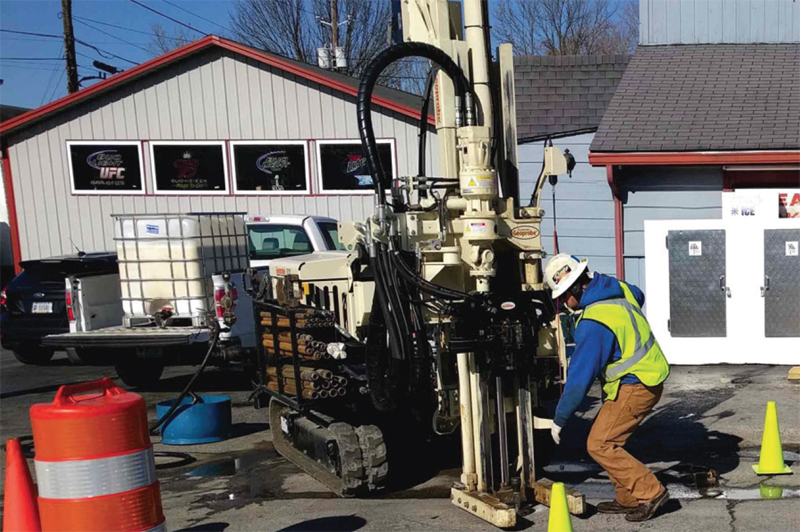 The ERD agent, 3-D-Microemulsion® (3DMe®) was injected along with Chemical Reducing Solution (CRS®), an ISCR augmentation. The ISCR agent delivers a source of ferrous iron, designed to precipitate as reduced iron minerals and provide an additional abiotic pathway for the destruction of PCE. The two work synergistically, increasing the cost effectiveness of the injection. The pre-sampling of DHC revealed that the population of DHC needed to be augmented. 10 gallons of BDI® Plus (DHC enhanced fluid) was injected at each of the 92 injection locations used for the ERD/ISCR. The combination of these three injected materials allows for minimal site disturbance and a high level of effectiveness for the cleanup of drycleaning solvents.
The ERD agent, 3-D-Microemulsion® (3DMe®) was injected along with Chemical Reducing Solution (CRS®), an ISCR augmentation. The ISCR agent delivers a source of ferrous iron, designed to precipitate as reduced iron minerals and provide an additional abiotic pathway for the destruction of PCE. The two work synergistically, increasing the cost effectiveness of the injection. The pre-sampling of DHC revealed that the population of DHC needed to be augmented. 10 gallons of BDI® Plus (DHC enhanced fluid) was injected at each of the 92 injection locations used for the ERD/ISCR. The combination of these three injected materials allows for minimal site disturbance and a high level of effectiveness for the cleanup of drycleaning solvents.
An often overlooked byproduct of the ERD process is methane. As a preventative measure, the field staff upgraded the site building SSDS with an intrinsically-safe fan and installed an intrinsically-safe SSDS at the offsite building as an interim measure. Soil gas points were also BDI Plus is an enriched natural microbial consortium containing species of Dehalococcoides sp. (DHC). This microbial consortium has since been enriched to increase its ability to rapidly dechlorinate contaminants during in situ bioremediation processes. Chemical Reducing Solution is an iron-based amendment for in situ chemical reduction (ISCR) of halogenated hydrocarbon contaminants such as chlorinated ethenes and ethanes. installed between the injection areas and the adjoining properties to the east. Additionally, extra intrinsically-safe fans and piping are ready to be installed.
Technology Description
3-D Microemulsion is an engineered electron donor material that offers a novel 3-stage electron donor release profile, pH neutral chemistry, and is delivered on-site as a factory emulsified product.
BDI Plus is an enriched natural microbial consortium containing species of Dehalococcoides sp. (DHC). This microbial consortium has since been enriched to increase its ability to rapidly dechlorinate contaminants during in situ bioremediation processes.
Chemical Reducing Solution is an iron-based amendment for in situ chemical reduction (ISCR) of halogenated hydrocarbon contaminants such as chlorinated ethenes and ethanes.
Results
The results from the first injection event were very promising. Groundwater contaminant concentration went down from thousands of μg/L pre-injection to single digits μg/L one month post-injection. Quarterly groundwater sampling will continue for a year or two to demonstrate that the contaminant plume is retreating or remediated. The ultimate goal of the ERD approach is to reach site closure quickly, and reduce the costs and health risks of this contamination.

 Americas
Americas Europe
Europe Français
Français Deutsch
Deutsch Italiano
Italiano Español
Español
